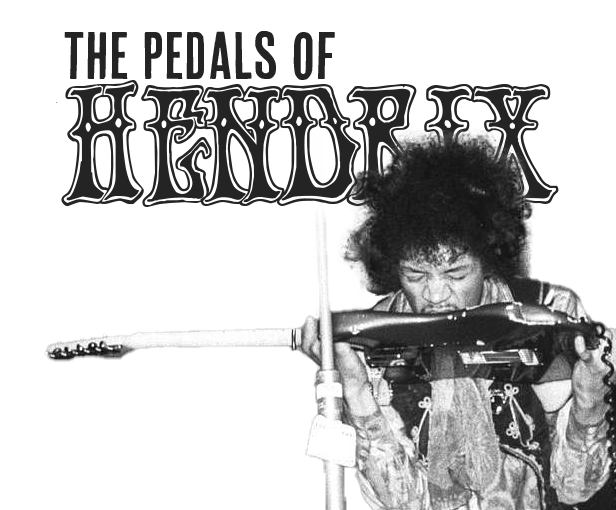
A Brief History
“I met Roger Mayer at a session, and he said, ‘Is there something in electronic music, with the guitar, that you could think of that would be a good asset to have?’ And I said, “Yeah, absolutely.’ I played him music with overdriven guitar, and I said, ‘That’s what it needs.’” - Jimmy Page
In the early ‘60s, Roger Mayer was an acoustic engineer for the British Admiralty. He worked in the vibration and acoustic research field regarding underwater warfare. At a gig in southwest London, Mayer met a young guitarist, and in 1964, he began building fuzz boxes for that guitarist/studio musician by the name of Jimmy Page. Page recounts the first time he debuted Mayer’s creation in an interview with Rolling Stone: “I was doing studio work at the time, and I had this thing [he made] in the back of my amplifier. It was quite small. Normally, session producers would say, ‘Have you got anything for this song?’ And I’d just come up with riffs. This time, I said, ‘Let’s see if [the fuzz box] works.’”

At that time, guitarists had few options for creating distorted sounds outside of cranking the amplifier or “modifying” the speaker. Page said, “So I put it in, and the faces of the other guitarists, who were seven years older than me, turned ashen white because they thought, ‘Oh, my God. This little punk is really filling all the different roles of guitar playing, and now he’s got this thing.’ Anyway. It got established immediately, and I was getting called up to do sessions. ‘Bring your own fuzz box,’ et cetera.”
In addition to Page, Big Jim Sullivan and Jeff Beck were two of the early adopters of Mayer’s early fuzz boxes. Beck used it within his band, The Yardbirds, and Sullivan utilized the effect in numerous studio sessions. Most notably, Sullivan can be heard playing the early Mayer fuzz box (on loan from Jimmy Page) on two P.J. Proby hit records: “Hold Me” and “Together.” Page can be heard using the fuzz box on the Kinks and the Who recordings. “You can hear the fuzz box on the Kinks’ first album. I think on the B side of the Who’s I Can’t Explain, Bald Headed Woman, I think there’s a few phrases on the fuzz box that come out on that,” says Page.
Following his initial fuzz boxes’ success, Mayer created a new effect that modulated the guitar’s signal. Page was the first to try out this unnamed effect and said, "It was difficult to control in the studio from the guitar, so I said it wasn’t for me."
Hendrix and “Octavio”

On January 11, 1967, at Nell’s club in Soho, London, Roger Mayer met a young American guitarist named Jimi Hendrix. “I introduced the Octavia to Jimi back in early 1967… We were both into new and innovative sounds, and I mentioned I’d helped out Jeff Beck and Jimmy Page with some of my stuff for their hit records. Jimi asked me if I had anything new, and I told him about this new pedal – the Octavia.”
Mayer brought the new Octavia effect to Hendrix’s gig the following week at Chiselhurst Caves in Kent. In the dressing room, Hendrix tried the unique effect through a practice amp and said, "I know what I can use this for. Come down to the Ricky Tick Club gig next week; we’re going to Olympic Studios after the show to record the overdubs for Purple Haze and Fire."
Using a Fender Telecaster (because his Stratocaster was damaged from a previous gig), Jimi Hendrix recorded the guitar solo for "Purple Haze" with the first iteration of the Octavia on February 3, 1967. This was the first time in history that the Roger Mayer Octavia was used on a recording. This early version of the Octavia was very different from what we think today. It did not have the same circuit, transformer, or wedge-shaped enclosure we have come to know. Mayer refers to this version as the Octavia Evo 1. It featured germanium transistors and a ferrite transformer and was accompanied by a separate germanium driver pedal to drive the octave circuit harder. After the session for “Purple Haze” and “Fire,” Evo 1 was discarded, and Mayer decided that the driver section and octave circuit should be in the same enclosure.
Hendrix and Mayer continued to refine the Octavia. According to Mayer, “The path of development and understanding through experimentation by Jimi and I was continuous and fast like in F1 Motor Racing, and in the space of less than a year, at least 15 variations and evolutions had been produced…These units were used by Jimi and not housed in a wedge shaped box. Some only had a life of a week or so as we both learned and experimented and moved on.”
On May 4, 1967, eight days before the release of “Are You Experienced?”, the Jimi Hendrix Experience and Mayer began tracking their follow-up album, “Axis: Bold as Love.” The latest version of Octavia made an appearance on “Little Wing,” “One Rainy Wish,” and “Little Miss Lover.” Mayer was also modding some of Jimi’s other effects while in the studio to accompany Octavia better. By the end of 1967, “Axis: Bold as Love” was released, and Mayer began housing the Octavia in the iconic wedge-shaped enclosure. Only five of this version of Octavia were made, and they now included a DPDT (double pole, double throw) switch, making them better suited for live show applications.
Mayer accompanied the band on their US tour from January 30 - April 19, 1968, where the Octavia made its US debut. Due to the custom build of the pedal, audience members stealing gear, and the difficulty getting parts while on the road, the Octavia was only used on a handful of gigs throughout the tour.

Mayer began working at Olympic Studios designing and manufacturing consoles and outboard equipment, all while keeping in contact with Hendrix to continue the development of the Octavia. Witnessing the toll that touring takes on gear first-hand, Mayer decided to replace the germanium transistors with the more temperature-stable silicon transistors and swap the ferrite transformer for a more robust iron transformer. This made the Octavia better suited for different climates as well as the rigors of the road.
At the end of 1969, Hendrix formed a new band with bassist Billy Cox and drummer Buddy Miles called Band of Gypsys. Armed with a new repertoire, the trio booked December 31, 1969, and January 1, 1970, at the historic Fillmore East. Having lost his other units, Hendrix called Mayer asking to get an Octavia for the upcoming shows. Mayer gave Hendrix an Octavia and distortion from a batch he made earlier that year, and those sounds can be heard on the “Band of Gypsys” live album. Hendrix used the Octavia throughout 1970; his last known recording of using it is from his performance in Milwaukee, Wisconsin, on May 2, 1970.
Octavia and the Modern Pedal Market
As with all Hendrixian effects, there is no shortage of clones, replicas, off- shoots, and recreations of the Octavia. MXR, Electro-Harmonix, and Danelectro are significant players in the mass-produced Octavia/Octave-fuzz space. Pedals in this category are in the price range of ~$50-$225. Roger Mayer’s current production of effects pedals occupy the boutique/niche sector and other companies such as Chicago Iron, King Tone, and Beetronics FX. These pedals can range in price from ~$250-500.
The most comprehensive price range comes from the vintage/out-of-production sector. Old Octavia-inspired pedals can be found for as low as $150, but the sky is the limit on others, primarily if a particular provenance is associated with the pedal. Vintage, non-Hendrix-owned, Octavia-styled pedals (Tycobrahe Octavia) top out at ~$3,500. In December 2020, at Julien’s Icon and Idols Trilogy: Rock ’n’ Roll auction, the Octavia used by Jimi Hendrix during his first shows with Band of Gypsys and the subsequent live record was auctioned for $70,400. A letter from Roger Mayer confirming the authenticity of the pedal was included, along with a later video interview and video of Hendrix utilizing it during the two-night run.
In 2021, Mayer released a new, limited 100-unit batch of Purple Haze Octavia pedals. These hand-signed/numbered pedals are the first time Mayer has released a wedge-shaped Octavia since the 1960s. These rare Octavias were released at a street price of £1,440 and are sure to increase in value.
Mayer said when talking about his latest release, “But this one doesn’t just use a battery; it also takes nine to 24 volts DC. The higher the voltage, the greater the headroom or output capacity – the signal distorts. So you can get the perfect Octavia sound and boost it with a higher output, which makes it much more usable in the studio. When I was in the studio with Jimi, we had access to a variable power supply so that we could fine-tune the sound of the Octavia…It sounds alien, but it also sounds human. It was made for making hit records, and it debuted on arguably Jimi Hendrix’s most famous record – Purple Haze. It’s got an impeccable heritage. If you want a genuine Octavia tone, you need to buy a genuine pedal. Some of my early pedals go for a lot more money; the original Band of Gypsys Octavia just went for $70,400!”

